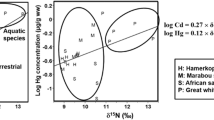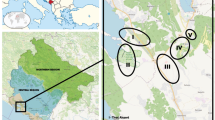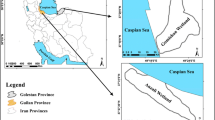Abstract
The differences in metal exposure (As, Cd, Cu, Pb and Hg) in the muscle, liver and kidney tissues of brown bears (Ursus arctos), grey wolfs (Canis lupus), Eurasian lynxs (Lynx lynx), Eurasian badgers (Meles meles) and pine martens (Martes martes) from Croatia were observed. The highest mean Cd levels were found in kidney and liver of Eurasian badger (3.05 and 0.537 mg/kg). The highest Cu concentrations (mg/kg) measured in liver tissue were obtained in order: Eurasian badger (15.2) > brown bear (12.1) > pine marten (10.3) > Eurasian lynx (8.43) > grey wolf (6.44). Result presented that Eurasian badger accumulated the highest levels of elements: As, Cu and Pb in muscle; As, Cd, Cu and Pb in liver; Cd and Pb in kidney. Kidney of pine marten accumulated the highest concentrations of As, Cu and Hg. Omnivorous species observed present an important bioindicator for the accumulation of toxic elements indicating an enhanced vulnerability for response to ecological changes in forested terrain. Generally, element concentrations found in five species observed were lower in comparison to levels reported in previous studies and below levels related to toxicosis in mammals.
Similar content being viewed by others
References
Alleva E, Francia N, Pandolfi N, De Marinis AM, Chiarotti F, Santucci D (2006) Organochlorine and heavy-metal contaminants in wild mammals and birds of Urbino-Pesaro Province, Italy: an analytical overview for potential bioindicators. Arch Environ Contam Toxicol 51:123–134
Gamberg M, Braune BM (1999) Contaminant residue levels in arctic wolves (Canis lupus) from the Yukon Territory, Canada. Sci Total Environ 243–244:329–338
Hoekstra PF, Braune BM, Elkin B, Armstrong FA, Muir DC (2003) Concentrations of selected essential and non-essential elements in arctic fox (Alopex lagopus) and wolverines (Gulo gulo) from the Canadian Arctic. Sci Total Environ 309:81–92
Horai S, Minagawa M, Ozaki H, Watanabe I, Takeda Y, Yamada K, Ando T, Akiba S, Abe S, Kuno K (2006) Accumulation of Hg and other heavy metals in the Javan mongoose (Herpestes javanicus) captured on Amamioshima Island, Japan. Chemosphere 65:657–665
Kusak J, Huber Đ, Gomerčić T, Schwaderer G, Gužvica G (2009) The permeability of highway in Gorski kotar (Croatia) for large mammals. Eur J Wildl Res 55:7–21
Ma WC (1996) Lead in mammals. In: Beyer WN, Heinz GH, Redmon-Norwood AW (eds) Environmental contaminants in wildlife: interpreting tissue concentrations. CRC Press, Boca Raton, pp 281–296
Millán J, Mateo R, Taggart MA, López-Bao JV, Viota M, Monsalve L, Camarero PR, Blázquez E, Jiménez B (2008) Levels of heavy metals and metalloids in critically endangered Iberian lynx and other wild carnivores from Southern Spain. Sci Total Environ 399:193–201
Newman J, Zillioux E, Rich E, Liang L, Newman C (2004) Historical and other patterns of monomethyl and inorganic mercury in the Florida panther (Puma concolor coryi). Arch Environ Contam Toxicol 48:75–80
Nikolaos PP, Nikolaos KP, Vasilios JK, Apostolos CT (2010) The dietary habits of the brown bear (Ursus arctos) in western Greece. Mamm Biol 75:29–35
Puls R (1994) Mineral levels in animal health. Sherpa International, Clearbrook
Reglero MM, Monsalve-González L, Taggart MA, Mateo R (2008) Transfer of metals to plants and red deer in an old lead mining area in Spain. Sci Total Environ 406:287–297
Sidorovich VE, Sidorovich AA, Krasko DA (2010) Effect of felling on red fox (Vulpes vulpes) and pine marten (Martes martes) diets in transitional mixed forest in Belarus. Mamm Biol 75:399–411
State Institute for Nature Protection (2009) http://www.life-vuk.hr/vuk-u-hrvatskoj/brojnost-i-trend-populacije-vuka-u-hrvatskoj/brojnost-i-trend-populacije-vuka-u-hrvatskoj-u-2009-godini-168.html
Woshner VM, O’Hara TM, Bratton GR, Beasley VR (2001) Concentrations and interactions of selected essential and non-essential elements in ringed seals and polar bears of arctic Alaska. J Wildl Dis 37:711–721
Yates DE, Mayack DT, Munney K, Evers DC, Major A, Kaur T, Taylor RJ (2005) Mercury Levels in Mink (Mustela vison) and River Otter (Lontra canadensis) from Northeastern North America. Ecotoxicology 14:263–274
Acknowledgments
The authors are thankful to all those who contributed to the study. Special thanks go to Marijana Fluka and Mirjana Hren for assistance in sample preparation. The study was supported with a grant from the Croatian Veterinary Institute, Zagreb, Croatia.
Author information
Authors and Affiliations
Corresponding author
Rights and permissions
About this article
Cite this article
Bilandžić, N., Dežđek, D., Sedak, M. et al. Trace Elements in Tissues of Wild Carnivores and Omnivores in Croatia. Bull Environ Contam Toxicol 88, 94–99 (2012). https://doi.org/10.1007/s00128-011-0449-y
Received:
Accepted:
Published:
Issue Date:
DOI: https://doi.org/10.1007/s00128-011-0449-y




